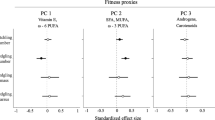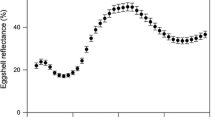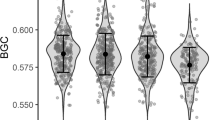Abstract
Females are expected to partition resources between offspring in a context-dependent way to maximise total fitness returns from a reproductive attempt. Female zebra finches (Taeniopygia guttata) vary the allocation of yolk androgens and antioxidants among offspring. Importantly, the balance between androgens and antioxidants in yolks may be more important than their independent absolute amounts in terms of fitness consequences for developing young. Therefore, we tested whether the relative allocation of these two resources in yolks varies according to either the Trivers–Willard, positive or compensatory maternal investment hypothesis. We manipulated male attractiveness using coloured leg bands (red-banded males appear attractive; green-banded males, unattractive) and measured yolk androgens and antioxidants in each egg, egg sex, clutch sex ratio and female condition. While female zebra finches manipulated the balance of androgens and antioxidants within and between clutches in response to mate attractiveness, offspring sex and their own condition, they did not do so in a way that consistently followed any of the hypotheses. Mothers paired with unattractive males allocated a larger antioxidant/androgen ratio to daughters than sons. This pattern was reversed when paired to an attractive male; sons received a larger antioxidant/androgen ratio than daughters. We also found offspring sex ratio decreased with increasing female condition for unattractive males, but not for attractive males. However, without knowing the fitness consequences of the balance of different egg constituents, it is difficult to interpret the patterns consistently in terms of the Trivers–Willard, compensatory and positive investment hypotheses.



Similar content being viewed by others
References
Alonso-Alvarez C, Bertrand S, Devevey G, Prost J, Faivre B, Sorci G (2004) Increased susceptibility to oxidative stress as a proximate cost of reproduction. Ecol Lett 7:363–368
Birkhead TR, Hunter FM, Pellatt JE (1989) Sperm competition in the zebra finch, Taeniopygia-guttata. Anim Behav 38:935–950. doi:10.1016/s0003-3472(89)80135-6
Birkhead TR, Burke T, Zann R, Hunter FM, Krupa AP (1990) Extra-pair paternity and intraspecific brood parasitism in wild zebra finches Taeniopygia guttata, revealed by DNA fingerprinting. Behav Ecol Sociobiol 27:315–324
Blount JD, Houston DC, Surai PF, Møller AP (2004) Egg-laying capacity is limited by carotenoid pigment availability in wild gulls Larus fuscus. Proc R Soc Lond B 271:S79–S81
Bolund E, Schielzeth H, Forstmeier W (2009) Compensatory investment in zebra finches: females lay larger eggs when paired to sexually unattractive males. Proc R Soc Lond B 276:707–715
Boncoraglio G, Groothuis TGG, von Engelhardt N (2011) Differential maternal testosterone allocation among siblings benefits both mother and offspring in the zebra finch Taeniopygia guttata. Am Nat 178:64–74
Burley N (1981) Sex ratio manipulation and selection for attractiveness. Science 211:721–722
Burley N (1986) Sex-ratio manipulation in color-banded populations of zebra finches. Evolution 40:1191–1206
Burley N (1988) The differential-allocation hypothesis: an experimental test. Am Nat 132:611–628
Cucco M, Guasco B, Malacarne G, Ottonelli R, Tanvez A (2008) Yolk testosterone levels and dietary carotenoids influence growth and immunity of grey partridge chicks. Gen Comp Endocrinol 156:418–425
Cunningham EJA, Russell A (2000) Egg investment is influenced by male attractiveness in the mallard. Nature 404:74–77
Duffy DL, Bentley GE, Drazen DL, Ball GF (2000) Effects of testosterone on cell-mediated and humoral immunity in non-breeding adult European starlings. Behav Ecol 11:654–662
Eising CM, Groothuis TGG (2003) Yolk androgens and begging behaviour in black-backed gull chicks: an experimental field study. Anim Behav 66:1027–1034
Gil D (2008) Hormones in avian eggs: a review. Adv Study Behav 38:337–398
Gil D, Graves J, HazonN WA (1999) Male attractiveness and differential testosterone investment in zebra finch eggs. Science 286:126–128
Gil D, Leboucher G, Lacroix A, Cue R, Kreutzer M (2004) Female canaries produce eggs with greater amounts of testosterone when exposed to preferred male song. Horm Behav 45:64–70
Gilbert L, Rutstein AN, Hazon N, Graves JA (2005) Sex-biased investment in yolk androgens depends on female quality and laying order in zebra finches (Taeniopygia guttata). Naturwissenschaften 92:178–181
Gilbert L, Williamson KA, Hazon N, Graves JA (2006) Maternal effects due to male attractiveness affect offspring development in the zebra finch. Proc R Soc Lond B 273:1765–1771
Gilbert L, Bulmer E, Arnold KE, Graves JA (2007) Yolk androgens and embryo sex: maternal effects or confounding factors? Horm Behav 51:231–238
Gilbert L, Williamson KA, Graves JA (2011) Male attractiveness regulates offspring fecundity non-genetically via maternal investment. Proc R Soc Lond B. doi:10.1098/rspb.2011.0962
Gowaty PA, Anderson WW, Bluhm CK, Drickamer LC, Kim YK, Moore AJ (2007) The hypothesis of reproductive compensation and its assumptions about mate preferences and offspring viability. Proc Natl Acad Sci USA 104:15023–15027
Griffith SC, Holleley CE, Mariette MM, Pryke SR, Svedin N (2010) Low level of extra pair parentage in wild zebra finches. Anim Behav 79:261–264
Groothuis TGG, Muller W, von Engelhardt N, Carere C, Eising C (2005) Maternal hormones as a tool to adjust offspring phenotype in avian species. Neurosci Biobehav Rev 29:329–352
Groothuis TGG, Eising CM, Blount JD, Surai P, Apanius V, Dijkstra C, Muller W (2006) Multiple pathways of maternal effects in black-headed gull eggs: constraint and adaptive compensatory adjustment. J Evol Biol 19:1304–1313
Hargitai R, Arnold KE, Herenyi M, Prechl J, Torok J (2009) Egg composition in relation to social environment and maternal physiological condition in the collared flycatcher. Behav Ecol Sociobiol 63:869–882
Harris WE, Uller T (2009) Reproductive investment when mate quality varies: differential allocation versus reproductive compensation. Phil Trans R Soc B-Bio Sci 364:1039–1048
Hunt S, Cuthill IC, Swaddle JP, Bennett ATD (1997) Ultraviolet vision and band-colour preferences in female zebra finches, Taeniopygia guttata. Anim Behav 54:1383–1392
Ketterson ED, Nolan V (1999) Adaptation, exaptation, and constraint: a hormonal perspective. Am Nat 154:S4–S25
Kilner R (1998) Primary and secondary sex ratio manipulation by zebra finches. Anim Behav 56:155–164
Lipar JL, Ketterson ED (2000) Maternally derived yolk testosterone enhances the development of the hatching muscle in the red-winged blackbird Agelaius phoeniceus. Proc R Soc Lond B 267:2005–2010
Martins TLF (2004) Sex-specific growth rates in zebra finch nestlings: a possible mechanism for sex ratio adjustment. Behav Ecol 15:174–180
Monaghan P, Nager RG (1997) Why don’t birds lay more eggs? Trends Ecol Evol 12:270–274
Müller W, Boonen S, Groothuis TGG, Eens M (2010) Maternal yolk testosterone in canary eggs: toward a better understanding of mechanisms and function. Behav Ecol 21:493–500
Navara KJ, Hill GE, Mendonca MT (2005) Variable effects of yolk androgens on growth, survival, and immunity in eastern bluebird nestlings. Physiol Biochem Zool 78:570–578
Navara KJ, Hill GE, Medonca MT (2006a) Yolk androgen deposition as a compensatory strategy. Behav Ecol Sociobiol 60:392–398
Navara KJ, Badyaev AV, Mendonca MT, Hill GE (2006b) Yolk antioxidants vary with male attractiveness and female condition in the house finch (Carpodacus mexicanus). Physiol Biochem Zool 79:1098–1105
Petrie M, Williams A (1993) Peahens lay more eggs for peacocks with larger trains. Proc R Soc Lond B 251:127–131
Royle NJ, Surai PF, Hartley IR (2001) Maternally derived androgens and antioxidants in bird eggs: complementary but opposing effects? Behav Ecol 12:381–385
Rutstein AN, Gilbert L, Slater PJB, Graves JA (2004a) Mate attractiveness and primary resource allocation in the zebra finch. Anim Behav 68:1087–1094
Rutstein AN, Slater PJB, Graves JA (2004b) Diet quality and resource allocation in the zebra finch. Proc R Soc Lond B 271:S286–S289
Rutstein AN, Gilbert L, Slater PJB, Graves JA (2005a) Sex-specific patterns of yolk androgen allocation depend on maternal diet in the zebra finch. Behav Ecol 16:62–69
Rutstein AN, Gorman HE, Arnold KE, Gilbert L, Orr KJ, Adam A, Nager R, Graves JA (2005b) Sex allocation in response to paternal attractiveness in the zebra finch. Behav Ecol 16:763–769
Safran R, Pilz K, McGraw K, Correa S, Schwabl H (2008) Are yolk androgens and carotenoids in barn swallow eggs related to parental quality? Behav Ecol Sociobiol 62:427–438
Saino N, Bertacche V, Ferrari RP, Martinelli R, Møller AP, Stradi R (2002) Carotenoid concentration in barn swallow eggs is influenced by laying order, maternal infection and paternal ornamentation. Proc R Soc Lond B: 269:1729–1733
Saino N, Ferrari R, Romano M, Martinelli R, Møller AP (2003) Experimental manipulation of egg carotenoids affects immunity of barn swallow nestlings. Proc R Soc Lond B 270:2485–2489
Sandell MI, Tobler M, Hasselquist D (2009) Yolk androgens and the development of avian immunity: an experiment in jackdaws (Corvus monedula). J Exp Biol 212:815–822
Schwabl H (1993) Yolk is a source of maternal testosterone for developing birds. Proc Natl Acad Sci USA 90:11446–11450
Schwabl H (1996) Maternal testosterone in avian eggs enhances postnatal growth. Comp Biochem Physiol 114:271–276
Sheldon BC (2000) Differential allocation: tests, mechanisms and implications. Trends Ecol Evol 15:397–402
Sockman KW, Schwabl H (2000) Yolk androgens reduce offspring survival. Proc R Soc Lond B 267:1451–1456
Surai PF (2002) Natural antioxidants in avian nutrition and reproduction. Nottingham University Press, Nottingham
Tobler M, Sandell MI (2009) Sex-specific effects of prenatal testosterone on nestling plasma antioxidant capacity in the zebra finch. J Exp Biol 212:89–94
Trivers RL, Willard DE (1973) Natural selection of parental ability to vary sex ratio of offspring. Science 179:90–92
Verboven N, Monaghan P, Evans DM et al (2003) Maternal condition, yolk androgens and offspring performance: a supplemental feeding experiment in the lesser black-backed gull (Larus fuscus). Proc R Soc Lond B 270:2223–2232
von Engelhardt N, Carere C, Dijkstra C, Groothuis TGG (2006) Sex-specific effects of yolk testosterone on survival, begging and growth of zebra finches. Proc R Soc Lond B 273:65–70
von Schantz T, Bensch S, Grahn M et al (1999) Good genes, oxidative stress and condition-dependent sexual signals. Proc R Soc Lond B 266:1–12
Williams GC (1966) Adaptation and natural selection. Princeton University Press, Princeton
Williamson KA, Surai PF, Graves JA (2006) Yolk antioxidants and mate attractiveness in the Zebra Finch. Funct Ecol 20:354–359
Acknowledgements
We wish to thank Tanya Sneddon, Alan Wells, Bill Mullen, Rita Hargitai and Steve Larcombe for help in the lab and Isobel Maynard for care of the birds. ECP was funded by a Natural Environment Research Council studentship.
Ethical standards
This research was conducted under Home Office license to JG and complies with the UK Home Office regulations for animal experimentation.
Conflicts of interest
The authors have no conflict of interest.
Author information
Authors and Affiliations
Corresponding author
Additional information
Communicated by T. Bakker
Electronic supplementary material
Below is the link to the electronic supplementary material.
ESM 1
(DOC 78 kb)
Rights and permissions
About this article
Cite this article
Pariser, E.C., Gilbert, L., Hazon, N. et al. Mind the gap: the ratio of yolk androgens and antioxidants varies between sons and daughters dependent on paternal attractiveness. Behav Ecol Sociobiol 66, 519–527 (2012). https://doi.org/10.1007/s00265-011-1300-5
Received:
Revised:
Accepted:
Published:
Issue Date:
DOI: https://doi.org/10.1007/s00265-011-1300-5




